Every Central Texas Landscape Requires Maintenance
With a little advanced planning we can create a beautiful landscape that is functional, meets the needs of the entire family, and yet requires a minimum of time and money to maintain. Whether you are installing a new landscape or revamping an established one, by following a few simple suggestions you can end up with a wonderful low maintenance landscape that leaves you plenty of time for other activities.
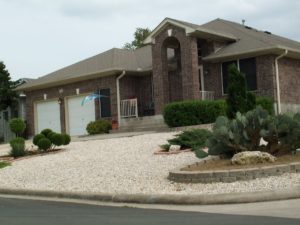
Desert “zero” scaping is not the only option
There is no such thing as a maintenance free landscape. While some wildscape designs can come pretty close, the fact that it is a designed landscape will necessitate some maintenance to maintain its form and beauty. Some folks have given up on landscaping altogether and are electing to spread rock across the property with a few cacti stuck in here and there. While it may seem like low maintenance, we get enough rainfall to do better than that and most cacti may end up drowning in a normal rainfall year.
Keep it Simple
The more elaborate you make a landscape, the more features you add, the more maintenance you will likely have. Great designs are often quite simple.
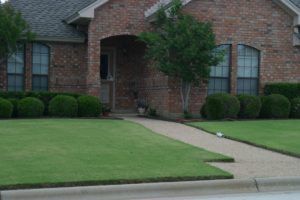
Difficult to mow angular corners
Every extra foot of bed edge, rockwork and fence line can mean more weeding, mowing, or edging. Elaborate plantings with an extensive variety of plants need more attention to keep them tidy and attractive. Special landscape features such as fountains require additional maintenance.
Design With Maintenance in Mind
Keep maintenance at the forefront as you plan your landscape. Group plants with similar care needs and place higher maintenance plantings near the home where the added beauty may justify the added work.
As you move outward from the home, design areas that need less maintenance. Place the majority of your time and money where you spend time outdoors. This is a type of zoning with high maintenance zones blending into zones with medium and finally low maintenance.
Make beds large and sweeping. Combine several small beds into a large one to reduce mowing time. Avoid sharp angles. Gradual curves are easier to mow and more aesthetically pleasing to the eye. If you have several trees close together in the lawn, consider creating a large bed around them. This will save time mowing and edging around each trunk and provide a place to toss the leaves as a natural mulch.
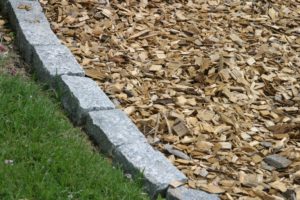
Curved stone pathway with wood mulch
Install edging to delineate between turf and bed areas. This will prevent St. Augustine and some Zoysias from invading but not Bermudagrass. When buying edging material choose metal edging or a better quality plastic product will last longer and look great. Stone is a great option too but may be more expensive.
A word about “cottage gardens” is in order. These haphazard designs seem to be the ultimate in low care. But in order for a cottage garden to look decent you will need to do some work removing the overzealous plants that spread by aggressive rhizomes or excessive reseeding.
Let Nature Maintain It For You
When the setting allows, place some natural areas around the periphery of your landscape, especially if your property adjoins a natural area. These natural areas will receive little if any care, but can contribute nicely to the overall effect. Select native trees and shrubs for these areas, or perhaps some tall native clumping grasses for sunny areas. Include some that bloom for seasonal interest. These natural areas are another place to toss extra leaves for another maintenance advantage.
Some folks have relegated most of their landscape to natural areas and just maintain a small spot where they can relax and entertain guests. It all comes down to what is aesthetically acceptable to you, but extensive design comes at a maintenance cost.
How Much Is Enough?
Lawns are nice, but just because you own the property is no reason to cover it all with grass. Lawns need mowing, watering and fertilizing, or they will get thin and weedy…which in turn brings the need for hand pulling or spraying.
There are areas where turf thrives and areas where it does not. Deep shade, shallow soil underlain by rock, and coarse unamended sand are all areas where turf will be an ongoing problem or maintenance chore. Turf areas can be an important part of your landscape when you consider that grass slows down run-off, prevents erosion, and filters pollutants. Treat it as a planting area instead of a default so that proper location and soil preparation can be done to reduce maintenance problems in the future.
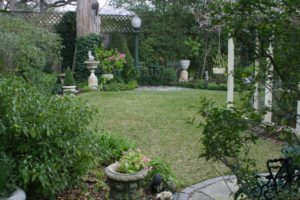
Small backyard with minimal turf
This same principle applies to other types of plant material. Flower beds are gorgeous but require a lot of maintenance. The overall landscape size should be considered with your family interests and maintenance time in mind. You can always expand the area or add more features later if you wish.
Start Off Weed Free
Weeds are much easier to deal with before your turfgrass and other landscape plants are in. This is especially true for perennial weeds such as bermudagrass, nutsedge, wild blackberry vines, and johnsongrass, to name of few of the more notorious invaders.
Whether you dig, spray or a combination of the two, do all you can to get rid of weeds so you can start with a clean slate. Weed block fabrics are a short-term solution that often are not worth the headache. You can’t easily add compost to the soil later or plant new successions of bedding plants unless you cut holes in the fabric. Worse, many aggressive weeds will grow through it and prevent you from getting to their roots.
Choose Easy Care Plants
Some plants are just plain high maintenance. Others need just a little help getting established and then do quite well on their own. Trees and shrubs generally require less maintenance. The exceptions are roses and fruit producing plants that may need a little extra spraying and/or pruning.
Slow growing and dwarf types require less pruning and are easier to keep in bounds. If you plant evergreen shrubs, keep in mind that shearing them into box or other shapes means regular trimming and much more work than maintaining them in a more natural shape or form.
Choose plants that are adapted to your area and not prone to disease or insect attack. Most types of Euonymus, for example, while widely planted are magnets for powdery mildew and/or scale, and should be avoided.
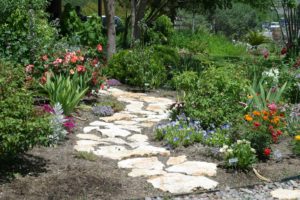
High maintenance plants, but great use of mulch
Annual flowers can keep you busy, planting, fertilizing, deadheading (in some cases), and then pulling them out to replant. To keep an area colorful you may be making three or more color changes a year. Perennials are a bit less trouble, but still need some grooming and feeding. Every so often they may also need dividing to keep them in top shape.This is certainly not to say that we should avoid flowers, just that to minimize maintenance, choose where you want them to go carefully to get maximum effect from minimum effort.
Clumping ornamental grasses are underutilized in our landscapes. They are very low care and add an attractive feature with the long lines and graceful movement in the wind. Cut them back in late winter and provide a little fertilizer and you’re pretty much done with their maintenance for the year.
Don’t crowd plants into a small space. Crowding makes it more difficult to work around plants and costs more initially as you are purchasing more plants than you need. Tightly spaced plants prevent good air circulation which can sometimes increase the incidence of diseases. Roses are an example of a plant that is more prone to foliar diseases when crowded.
Choose the Best Turf
What is the best turf species? There isn’t one that works in every situation. Your aesthetic preferences certainly weigh in, but so does drought tolerance, sunlight exposure, amount of foot traffic, and landscape design style.
Buffalograss is great when used west of Interstate 35 in a native or natural style landscape. You don’t mow it but twice a year and it gets about 6 inches high and lays over for a mini meadow look. You just have to remember that “it’s okay to be tan in summer”. While it can take the drought, it will turn brown until the next rain.
St. Augustine is maligned for being high maintenance, but in shade it is the grass of choice. It can take a lot of shade and in such conditions needs very little water. It also is tolerant of an infrequent mowing schedule and does not look as bad as most grasses after a long overdue mowing.
For higher traffic areas Bermuda and Zoysia are great choices. They do require regular mowing to look their best. Bermuda is especially invasive too and needs more frequent fertilizer applications to stay at the top of its game.
Mulch Your Cares Away
Mulching gives a great return on your time. When you lay down a thick layer of mulch annual weed seeds will be held at bay for the season. Watering will be reduced and over a few seasons as the mulch breaks down there will even be a release of nutrients to the plants.
Mulching is easy to do and makes garden beds look better too. Landscape fabric can help deter weeds, but a good layer of mulch is the better choice and can be pulled back for planting, fertilizing, and reworking the soil if needed.
Invest in Irrigation Design
Summertime heat puts a demand on our plants that rainfall can seldom match. Automatic irrigation systems certainly take a lot of work out of summer watering. It is important however that they are well designed. A poorly designed system wastes water, and therefore money, and may increase maintenance headaches as you replace poorly functioning sprinkler heads.
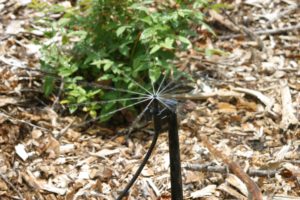
Microjet irrigation head as part of a drip irrigation system
When possible install drip or micro sprinkler irrigation to shrub and flower beds. Drip applies water more efficiently and by not wetting the foliage may reduce some plant disease problems.
A good timer can also make watering easier. Just make sure and use it properly and avoid watering more often than is necessary to keep the plants healthy.
These are a few tips to keep your maintenance chores to a minimum. Just remember the more elaborate and extensive your landscape the more likely you are to spend more time out there keeping it in shape. You can have a simple design that is also quite beautiful. So do some planning, looking, and thinking before building a new landscape or revamping an old one. Your time will be well spent.
Additional Resources for Low Maintenance Gardening
10 Ways to Make Your Landscape EARTH-KIND
Native & Adapted Plant Guide Searchable Database
